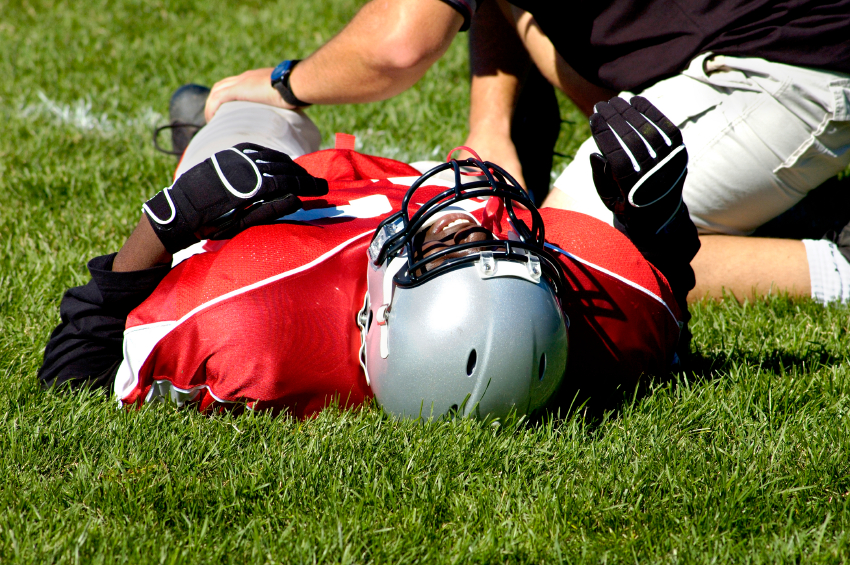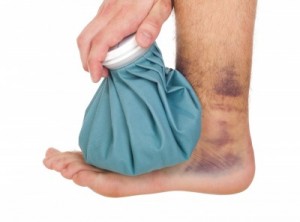Treating Soft Tissue Injuries

Tips For Treating Soft Tissue Injuries
- Contact your Physical Therapist immediately if you sustain a soft tissue injury.
- Use the RICE (rest, ice, compression, elevation) principle when a soft tissue injury occurs.
- Gentle, controlled motions will begin to restore the normal status of the injured tissue.
- Healing of soft tissue takes months and not weeks.
- Returning to full activity that uses the injured tissue should commence when there is no pain at rest and minimal pain during the activity.
Symptoms and Treatment for Soft Tissue Injuries
If you’re watching sports, and an athlete falls to the ground grabbing her ankle, it may be a soft tissue injury. Depending on the severity of the injury, the athlete may be out for the game and maybe even for the season. Sprains and strains impact muscles, ligaments, and tendons. They can cause as much pain and damage as a fracture.
Soft tissue injuries are pretty common. In fact, most of the injuries that out-patient, orthopaedic Physical Therapists treat are associated with soft tissue injuries. The good news is that the patient will usually enjoy full recovery.
Evaluating a Soft Tissue Injury
If a patient is suffering from a soft tissue injury, the Physical Therapist begins with an evaluation to determine what tissue type is injured, what symptoms are present, and what is the stage of healing (such as acute, sub-acute or chronic). Based on this evaluation, a rehabilitation program is initiated. For the purpose of this blog we will discuss the acute and sub-acute phase and the “normal” symptoms that someone would experience if they suffered an injury.
Soft Tissue and Healing
These injuries commonly occur in the tendon, ligament and muscle (skeletal) tissues. In most cases, all of these are able to regenerate and heal. The rate of healing is based on the amount of blood flow. Among these tissues, skeletal muscle has the greatest supply of blood. Tendons and ligaments are categorized as hypo-vascularized, and they have limited blood flow.
If one or more of these tissues are injured, the following sequence of events naturally begins within the injured tissue to prevent further injury and initiate the healing process:
1. The body begins protecting itself to prevent further injury. As a result, the injured person will experience pain, swelling, loss of motion and strength, and eventually loss of function in that area.
2. An acute, local release of enzymes into the system begins the inflammation process and causes the nerves to be hypersensitive. As a result, the injured area is painful and everything in the area is extremely sensitive to touch.
3. The area becomes swollen and “hot” due to an increase in the permeability of the cell wall, allowing cellular fluid to exit the cell via osmosis and enter into the interstitial space (space between the cells). If the fluid (swelling) remains in the interstitial space for a prolonged period of time (48+ hours) it can become much “thicker” or viscous and create an area of “pitting” edema. This area will be in and around the injury site and will be puffy, painful and if pressure is applied there will be an indentation in the skin that will take a significant amount of time to return to the normal appearance.
4. The area might become bruised or “black and blue.” The bruising might extend into distal (further from mid-line) portions of the limb and these areas might become swollen and painful. Any body part that is swollen will most likely lose its ability to move through the normal range of motion. The swelling and pain will cause the muscles to lose strength and become incapable of moving the body part normally. These symptoms will exist in the acute and sub-acute phase of healing.
Initial Treatment of Soft Tissue Injuries
 If you suffer a sprain or strain, it is important to control the inflammatory process. This will help stimulate healing of the injured tissue. The best way to begin to control inflammation is by using ice. Ice is a great analgesic and removes the heat from tissue, slowing down the effects of the enzyme reaction. The inflammatory process can inhibit healing, so it’s important to remove the inflammatory agents to speed the healing process.
If you suffer a sprain or strain, it is important to control the inflammatory process. This will help stimulate healing of the injured tissue. The best way to begin to control inflammation is by using ice. Ice is a great analgesic and removes the heat from tissue, slowing down the effects of the enzyme reaction. The inflammatory process can inhibit healing, so it’s important to remove the inflammatory agents to speed the healing process.
If this is primarily a muscle tissue injury, the use of NSAIDs (non-steroidal anti-inflammatory drugs) might cause more bleeding and should not be used within the first 24-48 hours. If this is an injury to the musculotendinous junction or tendon/ligament, then you can begin with NSAIDs immediately.
Treatment for Long-Term Recovery
While the injured tissue will heal without any treatment, Physical Therapy treatment will speed up the process and improve long-term rehabilitation. We recommend “active rest” instead of total immobility as the best plan for soft tissue rehabilitation. Gentle, controlled motion and exercises can help stimulate the healing process without causing more damage.
The Physical Therapist will perform several treatments that are geared toward reducing the swelling and getting the inflammation under control. The use of specific manual therapy techniques will help to restore normal motion and an exercise program will be implemented to restore the muscles ability to respond and move the body.
The natural healing process reproduces collagen fibers and “lays” them down to “patch” the injury site. Orientation of the new collagen fibers is haphazard and not in parallel configuration. The new tissue cannot withstand the same amount of force that the original tissue was able to handle, but with proper rehabilitation techniques the new tissue can be “re-aligned” and become as strong as the original. A proper exercise program can restore the normal configuration of collagen fibers and create a “strong patch” that resembles the original tissue.
Soft tissue injuries occur daily. The body’s initial response is to protect the injury site by producing pain, swelling, decreased motion, strength and function of the site. With proper treatment, the healing process will commence and be accelerated to restore the injured tissue to its original, pre-injury status and capable of withstanding or producing and transmitting the forces required to perform the activities of daily life.

























I am suffering Fluoroquinolones toxicity. I was treated 3 years for Fibromyalgia, during which time was on 9 prescriptions and spent 12 weeks in 2 orthopaedic boots to prevent rupture of Achilles Tendons. I figured out what I really have and stopped all meds, on top of my pain and fibro meds I was taking usually 3200 iu daily of Ibuprofen. After learning how those meds interfere with healing I stopped everything in September of 2015. I deal with great pain but usually make it with only very rare use of OTC analgesics.
I had a fall recently and injured the soft tissue on the right side near the ribs. It’s been a week and it is still painful. How long can I expect this pain and am I a candidate for physical therapy. I am resting and using ice. Occasionally I use a painkiller like Jerrold. I would appreciate your opinion. Thank you.